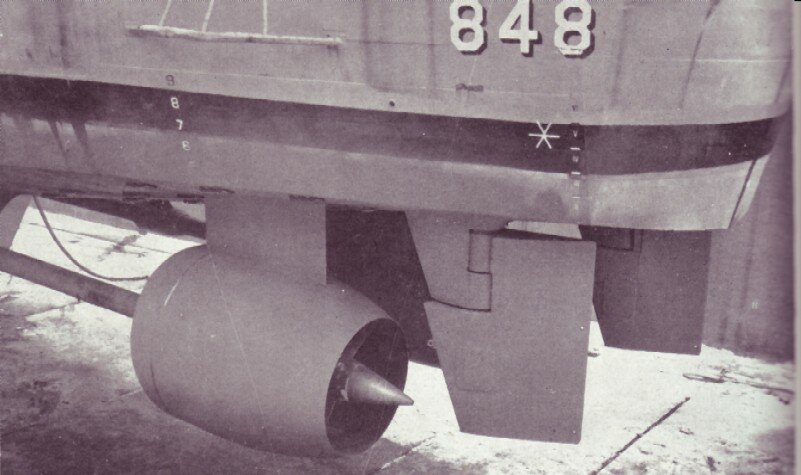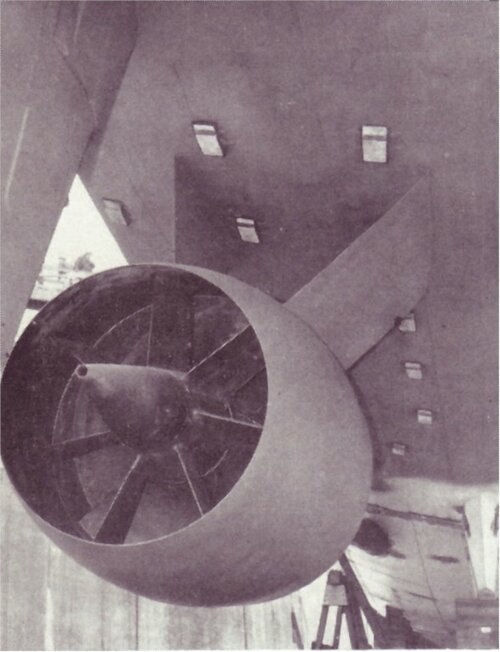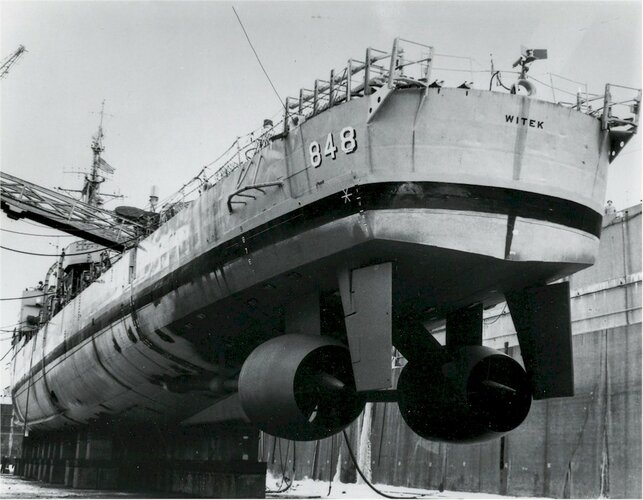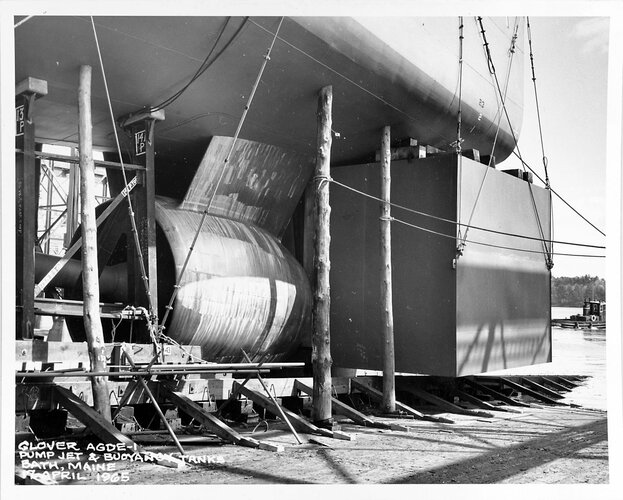You are using an out of date browser. It may not display this or other websites correctly.
You should upgrade or use an alternative browser.
You should upgrade or use an alternative browser.
Ship noise reduction techniques - why surface ship can’t be made as quiet as submarine?.
- Thread starter Ronny
- Start date
- Joined
- 11 February 2007
- Messages
- 2,343
- Reaction score
- 3,695
You can do some of it - Type 23 had CODLAG propulsion for low noise, letting them creep on electric drive when sub-hunting, together with rafted engines, but for most surface ships I suspect it isn't worth it.
And you have to remember subs are quiet when running on electric - whether battery or nuclear, they're less quiet when running on diesel, while warships are running on diesels or gas turbines almost all of the time.
And you have to remember subs are quiet when running on electric - whether battery or nuclear, they're less quiet when running on diesel, while warships are running on diesels or gas turbines almost all of the time.
Dilandu
I'm dissatisfied, which means, I exist.
Well, the Prairie-Masker systems are used since 1960s.What are noise surpression techniques used on surface destroyers such as Type055, Zumwalt, Aleigh Burke ?. Why the same techniques that make submarine so quiet can’t be used on surface ship?
The Masker component used a bubble curtain to disrupt the ship acoustic signature by emitting a compressed air from special belts around the hull. The bubbles create a zone of lesser density in water, so the acoustic waves emitted by ship's machinery are reflected back (mostly) and the ones that go outside are disrupted.
The Prairie component pump a compressed air to the trailing edge of propeller blades. The idea is to reduce screw cavitation (which is major source of noise). When the blade "rip" the water, creating vacuum bubbles, the compressed air, emitted from the blade, fill those bubbles, thus preventing them from collapsing loudly.
Both systems are the standard of USN, and apparently similar are used by other navies, including Royal Navy and Soviet/Russian Navy. They were installed also on several USN GUPPY-class submarines, but on surface ships they are more useful; firstly, they require a constant supply of compressed air to operate (so submarine could use it only under snorkel), secondly they create a highly reflective bubble trail over the submarine, that is very "bright" on active sonar, immediately attracting attention.
Vepr157
I like submarines
- Joined
- 20 December 2015
- Messages
- 32
- Reaction score
- 45
For submarines these aren't disadvantages. A snorkeling submarine is very loud because it is running its diesels and possibly cavitating due to its shallow depth. Thus Prairie-Masker effectively quiets a snorkeling submarine and would not be needed when deeply submerged anyway. And a submarine would not snorkel in a situation when it would be prone to detection by active sonar. The snorkel mast is a significant radar target, and there are chemical "sniffers" to detect diesel exhaust gasses, so if there were nearby adversarial ASW platforms, a submarine would not snorkel except in desperation.Both systems are the standard of USN, and apparently similar are used by other navies, including Royal Navy and Soviet/Russian Navy. They were installed also on several USN GUPPY-class submarines, but on surface ships they are more useful; firstly, they require a constant supply of compressed air to operate (so submarine could use it only under snorkel), secondly they create a highly reflective bubble trail over the submarine, that is very "bright" on active sonar, immediately attracting attention.
Dilandu
I'm dissatisfied, which means, I exist.
Yes, that's why they were installed on GUPPY-series refits. But when USN decided to go all nuclear with submarines, they have no more need to install Prairie-Masker on them. I'm not sure about NATO navies, that build diesel-electric submarines, though; did they use bubble curtain systems?For submarines these aren't disadvantages. A snorkeling submarine is very loud because it is running its diesels and possibly cavitating due to its shallow depth. Thus Prairie-Masker effectively quiets a snorkeling submarine and would not be needed when deeply submerged anyway. And a submarine would not snorkel in a situation when it would be prone to detection by active sonar. The snorkel mast is a significant radar target, and there are chemical "sniffers" to detect diesel exhaust gasses, so if there were nearby adversarial ASW platforms, a submarine would not snorkel except in desperation.
Vepr157
I like submarines
- Joined
- 20 December 2015
- Messages
- 32
- Reaction score
- 45
At least for submarines, it appears that Prairie-Masker was not adopted widely (if at all) beyond the U.S. Navy. I can't find any examples in other navies.
Why this is, I'm not sure. Although Prairie and Masker were originally classified, the idea that a bubble emission could reduce radiated noise is pretty old. The Royal Navy tested an equivalent of Prairie in 1917, although it apparently took until 1970 for the Royal Navy to employ it (under the name Agouti) and Masker on surface ships. So you would think that it would have been widely adopted.
Why this is, I'm not sure. Although Prairie and Masker were originally classified, the idea that a bubble emission could reduce radiated noise is pretty old. The Royal Navy tested an equivalent of Prairie in 1917, although it apparently took until 1970 for the Royal Navy to employ it (under the name Agouti) and Masker on surface ships. So you would think that it would have been widely adopted.
- Joined
- 16 April 2008
- Messages
- 9,374
- Reaction score
- 13,655
At least for submarines, it appears that Prairie-Masker was not adopted widely (if at all) beyond the U.S. Navy. I can't find any examples in other navies.
Why this is, I'm not sure. Although Prairie and Masker were originally classified, the idea that a bubble emission could reduce radiated noise is pretty old. The Royal Navy tested an equivalent of Prairie in 1917, although it apparently took until 1970 for the Royal Navy to employ it (under the name Agouti) and Masker on surface ships. So you would think that it would have been widely adopted.
The Prairie-Masker system was very large. The GUPPY boats that got it lost one of their four diesels in compensation for the air compressor.
Vepr157
I like submarines
- Joined
- 20 December 2015
- Messages
- 32
- Reaction score
- 45
The compressor wasn't very big; much of the space freed up by removing one of the diesels was used to relocate auxiliary equipment like pumps and motor-generators from the pump room, which was usually converted to an electronic equipment space and/or a sonar room. On submarines designed with Prairie-Masker, like the Barbels, the Prairie-Masker compressor was easily accommodated.The Prairie-Masker system was very large. The GUPPY boats that got it lost one of their four diesels in compensation for the air compressor.
But I’m curious, submarine certainly a very dangerous threat to surface fleet, if not the literal biggest threat. Why no surface ship seem to have things like pump jet propulsion or anechoic tile like a submarine?You can do some of it - Type 23 had CODLAG propulsion for low noise, letting them creep on electric drive when sub-hunting, together with rafted engines, but for most surface ships I suspect it isn't worth it.
And you have to remember subs are quiet when running on electric - whether battery or nuclear, they're less quiet when running on diesel, while warships are running on diesels or gas turbines almost all of the time.
Well, the Prairie-Masker systems are used since 1960s.
The Masker component used a bubble curtain to disrupt the ship acoustic signature by emitting a compressed air from special belts around the hull. The bubbles create a zone of lesser density in water, so the acoustic waves emitted by ship's machinery are reflected back (mostly) and the ones that go outside are disrupted.
The Prairie component pump a compressed air to the trailing edge of propeller blades. The idea is to reduce screw cavitation (which is major source of noise). When the blade "rip" the water, creating vacuum bubbles, the compressed air, emitted from the blade, fill those bubbles, thus preventing them from collapsing loudly.
Both systems are the standard of USN, and apparently similar are used by other navies, including Royal Navy and Soviet/Russian Navy. They were installed also on several USN GUPPY-class submarines, but on surface ships they are more useful; firstly, they require a constant supply of compressed air to operate (so submarine could use it only under snorkel), secondly they create a highly reflective bubble trail over the submarine, that is very "bright" on active sonar, immediately attracting attention.
Given that cavitating is the biggest source of noise on a ship, I still don’t understand why surface destroyer such as Arleigh burke doesn’t use things like pump jet or at least the design of submarine propeller with multiple blades. They still look very different


southwestforests
ACCESS: Top Secret
- Joined
- 28 June 2012
- Messages
- 672
- Reaction score
- 1,028
Dad would have known these kinds of things, but as for me, I am not an expert ship handler Navy veteran, so, all I can do is guess and imagine.I still don’t understand why surface destroyer such as Arleigh burke doesn’t use things like pump jet or at least the design of submarine propeller with multiple blades.
It may have to do with several things,
one being the operating environment,
Except for entering and leaving ports, the normal operating environment of a submarine is water at depth, which, while there are water variables in play, is, when compared to surface water, a stable environment.
The shallow depth where surface ship screws operate is not at all a stable environment, and in certain conditions ship propellors can be exposed, at least in part, to air instead of water.
In short, operating normally at depth and operating normally at the ocean-air interface may be factors in the difference.
And speaking of air,
I also have to wonder if some propellor difference arises from the surface ship also having to apply propulsion force to the water to counter weather wind forces whereas submarines usually do not.
You need to have a propellor which transfers enough energy to the water to merely move the ship's mass, to accelerate and decelerate the ship, to sometimes at low speed maneuver the ship by applying propellor thrust, that weather wind thing, the known amount of solid object debris floating around in surface zone water which your screws, propellors, might impact, and who knows what else that I in my life experience have no experience with.
The question to which I do not know the answer is, to what degree, percentage, do such things add factors to propellor design?
The difference is that ship operate at the interface of two fluids. There always will be noise as the ship disturbs both. They don't have the advantage of pressure at depths. Surfaces ships go faster.
- Joined
- 16 April 2008
- Messages
- 9,374
- Reaction score
- 13,655
But I’m curious, submarine certainly a very dangerous threat to surface fleet, if not the literal biggest threat. Why no surface ship seem to have things like pump jet propulsion or anechoic tile like a submarine?
Pump jets don't always behave well near the surface. They did look at a pump jet (aka an underwater discharge water jet) for DD-21 but the tech didn't really pan out. It was tested on the Seajet AESD test platform out on Pend Oreille, where they also tested the subscale Seawolf and Virginia class boats.

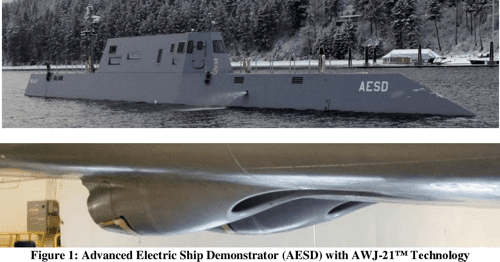
As for anechoic coatings, they have been tried, but there are major adhesion problems. One of the Canadian Halifaxes had tiles back in the 1990s and basically shed several million dollars worth of tiles in the span of a few months.
- Joined
- 16 April 2008
- Messages
- 9,374
- Reaction score
- 13,655
Surfaces ships go faster.
This is the only bit I'd disagree with. Modern nuke boats at least are in the same speed regime as surface ships, if not even faster.
Dilandu
I'm dissatisfied, which means, I exist.
Because Prairie system sufficiently solve the cavitation problem?Given that cavitating is the biggest source of noise on a ship, I still don’t understand why surface destroyer such as Arleigh burke doesn’t use things like pump jet or at least the design of submarine propeller with multiple blades. They still look very different
Prairie system make noise when buble collapsingBecause Prairie system sufficiently solve the cavitation problem?
I just realized the only military surface ship in production with pump jet is the VisbyPump jets don't always behave well near the surface. They did look at a pump jet (aka an underwater discharge water jet) for DD-21 but the tech didn't really pan out. It was tested on the Seajet AESD test platform out on Pend Oreille, where they also tested the subscale Seawolf and Virginia class boats.
View attachment 758167
View attachment 758168
As for anechoic coatings, they have been tried, but there are major adhesion problems. One of the Canadian Halifaxes had tiles back in the 1990s and basically shed several million dollars worth of tiles in the span of a few months.
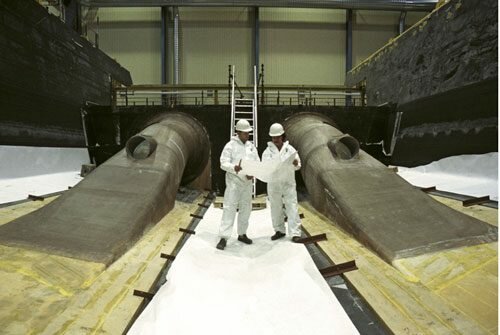
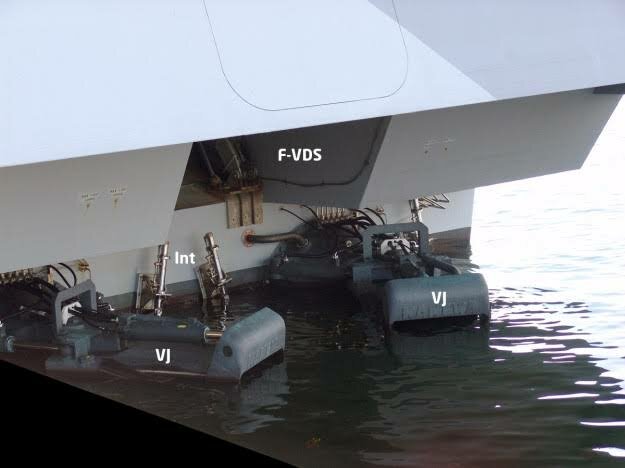
Dilandu
I'm dissatisfied, which means, I exist.
The whole idea of Prairie system is to prevent vacuum bubbles from forming & collapsing by bleeding compressed air from the trailing edge of propeller blade - so any rips blade made in water would be filled with air, and would not collapse.Prairie system make noise when buble collapsing
- Joined
- 16 April 2008
- Messages
- 9,374
- Reaction score
- 13,655
I just realized the only military surface ship in production with pump jet is the Visby
View attachment 758170
View attachment 758171
Not so. Those are waterjets, not pumpjets. They differ in that the water exits at or above the waterline. They are actually quite common on fast military vessels, including both classes of LCS.
Waterjets are powerful, but very, very loud.
Last edited:
Scott Kenny
ACCESS: Above Top Secret
- Joined
- 15 May 2023
- Messages
- 9,980
- Reaction score
- 11,484
The primary detection threat to a surface ship is not active sonar.But I’m curious, submarine certainly a very dangerous threat to surface fleet, if not the literal biggest threat. Why no surface ship seem to have things like pump jet propulsion or anechoic tile like a submarine?
Subs are approaching in passive, and will be using a visual approach via the periscope.
Vepr157
I like submarines
- Joined
- 20 December 2015
- Messages
- 32
- Reaction score
- 45
Pumpjets have been tried on surface ships, but they never really caught on (just FYI, the second image is of a rim-drive thruster and not a pumpjet per se). The U.S. Navy's first pumpjet was on the destroyer Witek, followed by an installation on the destroyer escort Glover. I am not able to find any official information regarding their performance, whether due to classification or just the fact that unclassified documents have not been digitized. Both were post-swirl pumpjets, where the fixed (stator) vanes were aft of the moving (rotor) blades. These are more efficient than pre-swirl pumpjets (which are often used on submarines), but not necessarily as quiet.Given that cavitating is the biggest source of noise on a ship, I still don’t understand why surface destroyer such as Arleigh burke doesn’t use things like pump jet or at least the design of submarine propeller with multiple blades. They still look very different
This is not strictly related to the discussion, but I wanted to mention that although the commonly-understood advantage of a pumpjet is that the shape of the duct suppresses cavitation, a less-appreciated advantage is that a pre-swirl pumpjet (where the stator blades are forward of the rotor) homogenizes the wake that the rotor operates in. Propeller operation in a non-uniform wake causes thrust fluctuations that lead to vibration and intermittent cavitation. Submarines have wakes behind each of the control surfaces and sail and thus suffer from this problem, but surface ships have huge wake variations due to the shape of the hull and position of the propellers. This is why highly-skewed propellers are used: each blade enters a new region of the wake progressively (i.e., the root hits the change in wake first, followed by the tip). A pre-swirl pumpjet is even better in this regard as the stator vanes blend the wake before it hits the rotor.
However, there are several reasons why pumpjets may not be desirable for a surface ship. The first is simply that a pumpjet weighs considerably more than a propeller (see section IX of the attached report). The Glover had to be rearranged and lost some fuel capacity as a result.
On ships with gas-turbine propulsion, for astern propulsion the main engines cannot be reversed, thus the propeller pitch must be reversed using controllable-pitch propellers. While it probably is possible to engineer a pumpjet with a controllable-pitch rotor, it would be difficult because of the minimal clearance between the propeller tips and the duct. That there is a very small clearance is important: it allows the propeller blades to be loaded to the tips and eliminates the tip vortices, increasing efficiency and decreasing noise.
Backing performance with pumpjets is also poor. For submarines, for which stealth is essential, the disadvantages of pumpjets are acceptable. For surface ships, apparently the disadvantages outweigh the acoustic and efficiency advantages
Attachments
Vepr157
I like submarines
- Joined
- 20 December 2015
- Messages
- 32
- Reaction score
- 45
Oh I forgot to mention: in regard to propellers with many blades (seven or more), it is a balance between efficiency, acoustic performance, and blade strength:
- All else being equal, generally propellers with fewer blades are more efficient.
- Propellers with more blades are (sometimes) quieter as the thrust fluctuations due to the propeller blades entering and exiting different parts of the wake are smoothed out. Compare a single-bladed propeller to one with an infinite number of blades (a disk). The single-bladed propeller will gain and lose thrust depending on what part of the wake it is in. The disk looks the same at all angles of rotation, thus there is zero thrust fluctuation.
- The larger the number of blades, the narrower their chord must be. And for a given section ("airfoil"), the thinner and weaker it will be. So a propeller with many blades may have to have a thicker, non-ideal section just to be strong enough. For highly skewed and raked propellers, the blades are already weak compared to a non-skewed propeller. This is also a problem for controllable-pitch propellers, which need a large hub just to fix the mechanisms for five blades. It gets increasingly hard erto cram the controllable-pitch mechanism into the hub as the number of blades are increased.
- Joined
- 5 May 2007
- Messages
- 1,339
- Reaction score
- 2,535
This is not the case with CODLAG or IEP drive, since the electric motor that actually drives the shaft can be reversed. If you don't have to use controllable pitch propellers, the constraints that brings for propeller design are removed and a much more extreme prop is possible.On ships with gas-turbine propulsion, for astern propulsion the main engines cannot be reversed, thus the propeller pitch must be reversed using controllable-pitch propellers.
Pumpjets have been tried on surface ships, but they never really caught on (just FYI, the second image is of a rim-drive thruster and not a pumpjet per se). The U.S. Navy's first pumpjet was on the destroyer Witek, followed by an installation on the destroyer escort Glover. I am not able to find any official information regarding their performance, whether due to classification or just the fact that unclassified documents have not been digitized. Both were post-swirl pumpjets, where the fixed (stator) vanes were aft of the moving (rotor) blades. These are more efficient than pre-swirl pumpjets (which are often used on submarines), but not necessarily as quiet.
This is not strictly related to the discussion, but I wanted to mention that although the commonly-understood advantage of a pumpjet is that the shape of the duct suppresses cavitation, a less-appreciated advantage is that a pre-swirl pumpjet (where the stator blades are forward of the rotor) homogenizes the wake that the rotor operates in. Propeller operation in a non-uniform wake causes thrust fluctuations that lead to vibration and intermittent cavitation. Submarines have wakes behind each of the control surfaces and sail and thus suffer from this problem, but surface ships have huge wake variations due to the shape of the hull and position of the propellers. This is why highly-skewed propellers are used: each blade enters a new region of the wake progressively (i.e., the root hits the change in wake first, followed by the tip). A pre-swirl pumpjet is even better in this regard as the stator vanes blend the wake before it hits the rotor.
However, there are several reasons why pumpjets may not be desirable for a surface ship. The first is simply that a pumpjet weighs considerably more than a propeller (see section IX of the attached report). The Glover had to be rearranged and lost some fuel capacity as a result.
On ships with gas-turbine propulsion, for astern propulsion the main engines cannot be reversed, thus the propeller pitch must be reversed using controllable-pitch propellers. While it probably is possible to engineer a pumpjet with a controllable-pitch rotor, it would be difficult because of the minimal clearance between the propeller tips and the duct. That there is a very small clearance is important: it allows the propeller blades to be loaded to the tips and eliminates the tip vortices, increasing efficiency and decreasing noise.
Backing performance with pumpjets is also poor. For submarines, for which stealth is essential, the disadvantages of pumpjets are acceptable. For surface ships, apparently the disadvantages outweigh the acoustic and efficiency advantages
Pump jets of surface ships have little in common with pump jets in submarines, e.g. one notable difference is, that the water pump jets in surface vessels allways exits above the water line. In fact, they can be very efficient and are used on commercial fast ferries.
Pump jets on surface ships cannot run backwards, since the exit is above the water line and they don't even need to do so. For driving backwards and manouvering, a vane guiding system on the water stream is used. This solution is very efficient, because it doesn't cause drag in normal operation.
Last edited:
- Joined
- 23 August 2011
- Messages
- 1,479
- Reaction score
- 4,291
Pump jets don't always behave well near the surface. They did look at a pump jet (aka an underwater discharge water jet) for DD-21 but the tech didn't really pan out. It was tested on the Seajet AESD test platform out on Pend Oreille, where they also tested the subscale Seawolf and Virginia class boats.
View attachment 758167
View attachment 758168
As for anechoic coatings, they have been tried, but there are major adhesion problems. One of the Canadian Halifaxes had tiles back in the 1990s and basically shed several million dollars worth of tiles in the span of a few months.
The new Type 26 appears to have 'acoustic shielding' on the outside of its hull as well....visible in the video below, and article...

What are the black sections on the Type 26 Frigate hull?
The Type 26 Frigate is an advanced submarine-hunting vessel, and by virtue of that fact, the class needs to have a low acoustic signature.
 ukdefencejournal.org.uk
ukdefencejournal.org.uk
- Joined
- 16 April 2008
- Messages
- 9,374
- Reaction score
- 13,655
Pump jets of surface ships have little in common with pump jets in submarines, e.g. one notable difference is, that the water pump jets in surface vessels allways exits above the water line.
You are describing waterjets, which are not the same as pumpjets. As illustrated above, actual pumpjets with submerged exhaust have been tried several times on surface ships but never been adopted. Designs range from essentially elaborate shrouded propellors to the underwater equivalent of a ducted fan. Some, like the AWJ-21 I mentioned earlier, are conceptually similar to waterjets but with submerged exhausts.
There is no clear distinction betwee waterjets and pumpjets. It's little suprising since in any case, they work with water and contain a pump to produce a jet flow of water...

 en.wikipedia.org
en.wikipedia.org
Pump-jet - Wikipedia
That true but then normal bubble still pop, just not as loud as the cavitating one, allegedly Prairie system sound like heavy rain while pump jet can be silentThe whole idea of Prairie system is to prevent vacuum bubbles from forming & collapsing by bleeding compressed air from the trailing edge of propeller blade - so any rips blade made in water would be filled with air, and would not collapse.
I know Surface ship can be detected by radar and other means, however, given that submarine is the biggest threat to surface ship, it would make a lot of sense to make them more quietThe primary detection threat to a surface ship is not active sonar.
Subs are approaching in passive, and will be using a visual approach via the periscope.
Vepr157
I like submarines
- Joined
- 20 December 2015
- Messages
- 32
- Reaction score
- 45
Just because wikipedia does not offer a clear distinction does not mean there is one. A pumpjet is typically defined as a ducted propulsor with a decelerating duct. A pumpjet typically has a large diameter, low RPM, short duct in relation to its diameter, has fixed components except for the rotor, and is always an axial flow design. It is much more akin to a traditional propeller than a pump. That the name contains the word "pump" is unfortunate and probably contributes to the confusion.There is no clear distinction betwee waterjets and pumpjets. It's little suprising since in any case, they work with water and contain a pump to produce a jet flow of water...

Pump-jet - Wikipedia
en.wikipedia.org
A waterjet has a small diameter, high RPM, a long duct, may have moving nozzles or thrust reversers, and may have an axial, centrifugal, or mixed flow design. It is much more akin to a pump than a traditional propeller. Both pumpjets and waterjets are examples of turbomachinery propulsors, but the difference is stark if you compare images of waterjets to the pumpjet photos posted above. One can really not confuse the two; they are very different.
Vepr157
I like submarines
- Joined
- 20 December 2015
- Messages
- 32
- Reaction score
- 45
I wouldn't say silent. Even for submarines, a pumpjet does not a silent submarine make. I'm not aware of any publicly-available information regarding surface ship pumpjet acoustics that one could base that claim on beyond general arguments about cavitation supression and (potentially) wake homogenization.That true but then normal bubble still pop, just not as loud as the cavitating one, allegedly Prairie system sound like heavy rain while pump jet can be silent
not really possible unless at very low speeds.I know Surface ship can be detected by radar and other means, however, given that submarine is the biggest threat to surface ship, it would make a lot of sense to make them more quiet
and the biggest threat is not submarines. Airborne or surface vessels/weapons are more of a threat. More countries can deploy those vs submarines.
Surface ship and aircraft are more popular sure, but they still aren’t nearly as dangerous as submarine. Modern destroyer such as Type055 and Arleigh burke have very good defensive and offensive capability against surface ship and aircraft. They can detect and engage aircraft and ships from hundreds of km, there are also multiple tool to jam and intercept anti ship missiles. By contrast, a submarine can go within a few km from the carrier fleet undetected, not to mention the fact that there is pretty much no method to intercept torpedos, and there is no way to jam a wake homing torpedo either. A submarine is the only weapon system that can single handedly sink the whole carrier fleetnot really possible unless at very low speeds.
and the biggest threat is not submarines. Airborne or surface vessels/weapons are more of a threat. More countries can deploy those vs submarines.
- Joined
- 11 February 2007
- Messages
- 2,343
- Reaction score
- 3,695
You seem to be assuming submarines are undetectable, that's very much not the case. They're constantly at risk of detection from SOSUS, IUSS, patrol aircraft, organic ASW helicopters, towed arrays, hull sonars and your own SSNs and SSKs. Detection mechanisms include not just sonar, but MAD, lasers and a range of developmental esoteric stuff that may or may not work - neutrino detectors and muon beams, wake detectors, advanced chemical sensors, gravitometers, etc, etc.By contrast, a submarine can go within a few km from the carrier fleet undetected,
See https://www.secretprojects.co.uk/threads/detection-of-submarines.4774/
MAD range is like 500-800 meters, laser detection is about 200 meters. Wake detection doesn’t work unless sub are very near surface. Sonar are questionable at best against modern submarine. Sure you can still get lucky and detect a submarine but it significantly harder to find a submarine compared to an aircraft or a ship. You can easily detect an aircraft from 400-450 km with a powerful radar, but it would be considered luck to detect a submarine from 12-13 knYou seem to be assuming submarines are undetectable, that's very much not the case. They're constantly at risk of detection from SOSUS, IUSS, patrol aircraft, organic ASW helicopters, towed arrays, hull sonars and your own SSNs and SSKs. Detection mechanisms include not just sonar, but MAD, lasers and a range of developmental esoteric stuff that may or may not work - neutrino detectors and muon beams, wake detectors, advanced chemical sensors, gravitometers, etc, etc.
See https://www.secretprojects.co.uk/threads/detection-of-submarines.4774/
Still doesn't mean they aren't threats.Surface ship and aircraft are more popular sure, but they still aren’t nearly as dangerous as submarine.
Again, there is no way of preventing noise if ships are going to move through the water at a reasonable speed.
- Joined
- 11 February 2007
- Messages
- 2,343
- Reaction score
- 3,695
If sonar isn't able to detect a modern submarine, why is everyone carrying around ASW weapons?Sonar are questionable at best against modern submarine.
ETA: And for that matter why is everyone building ASW frigates.
Last edited:
Yes, and I don’t suggest surface ship should get rid of defensive system against aircraft and other surface shipStill doesn't mean they aren't threats.
I would assume the same also true for submarine?Again, there is no way of preventing noise if ships are going to move through the water at a reasonable speed.
Sonar can detect a submarine of course, but the point is that a submarine can detect surface fleet from much greater distance than when it can be detectedIf sonar isn't able to detect a modern submarine, why is everyone carrying around ASW weapons?
no. a ship moving through the air/water interface will make more noise than a submarine at the same speed regardless of powerplant noiseI would assume the same also true for submarine?
Similar threads
-
Distant Thunder / NetSAT littoral water system (DARPA)
- Started by Grey Havoc
- Replies: 2
-
-
Is there a counter against submarine launched anti ship missile?
- Started by Ronny
- Replies: 5
-
-

